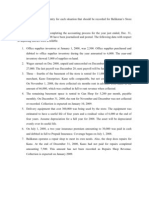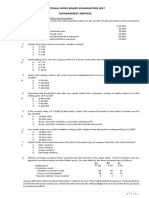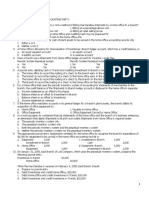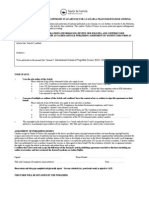Sample Accounting Exam
Sample Accounting Exam
Uploaded by
falmay1Copyright:
Available Formats
Sample Accounting Exam
Sample Accounting Exam
Uploaded by
falmay1Original Description:
Copyright
Available Formats
Share this document
Did you find this document useful?
Is this content inappropriate?
Copyright:
Available Formats
Sample Accounting Exam
Sample Accounting Exam
Uploaded by
falmay1Copyright:
Available Formats
Sample Exam Questions Cost Terms, Concepts, and Classifications
Multiple Choice
16. C Easy The corporate controllers salary would be considered a(n): a. manufacturing cost. b. product cost. c. administrative cost. d. selling expense. The cost of fire insurance for a manufacturing plant is generally considered to be a: a. product cost. b. period cost. c. variable cost. d. all of the above. For a manufacturing company, which of the following is an example of a period rather than a product cost? a. Depreciation of factory equipment. b. Wages of salespersons. c. Wages of machine operators. d. Insurance on factory equipment. Which of the following would be considered a product cost for external financial reporting purposes? a. Cost of a warehouse used to store finished goods. b. Cost of guided public tours through the company's facilities. c. Cost of travel necessary to sell the manufactured product. d. Cost of sand spread on the factory floor to absorb oil from manufacturing machines. Which of the following would NOT be treated as a product cost for external financial reporting purposes? a. Depreciation on a factory building. b. Salaries of factory workers. c. Indirect labor in the factory. d. Advertising expenses. The salary of the president of a manufacturing company would be classified as which of the following? a. Product cost b. Period cost c. Manufacturing overhead d. Direct labor Micro Computer Company has set up a toll-free telephone line for
17. A Medium
20. B Easy CPA adapted 21. D Medium
22. D Easy
24. B Easy
25.
D Easy
customer inquiries regarding computer hardware produced by the company. The cost of this toll-free line would be classified as which of the following? a. Product cost b. Manufacturing overhead c. Direct labor d. Period cost The wages of factory maintenance personnel would usually be considered to be: a. b. c. d. Indirect labor No Yes Yes No Manufacturing overhead Yes No Yes No
26. C Medium
27. C Medium CPA adapted
Direct materials are a part of: a. b. c. d. Conversion cost Yes Yes No No Manufacturing cost Yes Yes Yes No Prime cost No Yes Yes No
28. B Medium CPA adapted 29. A Medium
Manufacturing overhead consists of: a. all manufacturing costs. b. all manufacturing costs, except direct materials and direct labor. c. indirect materials but not indirect labor. d. indirect labor but not indirect materials. Which of the following should NOT be included as part of manufacturing overhead at a company that makes office furniture? a. sheet steel in a file cabinet made by the company. b. manufacturing equipment depreciation. c. idle time for direct labor. d. taxes on a factory building.
32. D Medium
Last month, when 10,000 units of a product were manufactured, the cost per unit was $60. At this level of activity, variable costs are 50% of total unit costs. If 10,500 units are manufactured next month and cost behavior patterns remain unchanged the: a. total variable cost will remain unchanged. b. fixed costs will increase in total. c. variable cost per unit will increase. d. total cost per unit will decrease. Variable cost: a. increases on a per unit basis as the number of units produced increases. b. remains constant on a per unit basis as the number of units produced increases.
33. B Easy
c. remains the same in total as production increases. d. decreases on a per unit basis as the number of units produced increases. 34. B Medium Within the relevant range, the difference between variable costs and fixed costs is: a. variable costs per unit fluctuate and fixed costs per unit remain constant. b. variable costs per unit are constant and fixed costs per unit fluctuate. c. both total variable costs and total fixed costs are constant. d. both total variable costs and total fixed costs fluctuate.
35. A Medium
Which of the following statements regarding fixed costs is incorrect? a. Expressing fixed costs on a per unit basis usually is the best approach for decision making. b. Fixed costs expressed on a per unit basis will react inversely with changes in activity. c. Assumptions by accountants regarding the behavior of fixed costs rest heavily on the concept of the relevant range. d. Fixed costs frequently represent long-term investments in property, plant, and equipment. An opportunity cost is: a. the difference in total costs which results from selecting one alternative instead of another. b. the benefit forgone by selecting one alternative instead of another. c. a cost which may be saved by not adopting an alternative. d. a cost which may be shifted to the future with little or no effect on current operations. Conversion cost consists of which of the following? a. Manufacturing overhead cost. b. Direct materials and direct labor cost. c. Direct labor cost. d. Direct labor and manufacturing overhead cost. Prime cost consists of direct materials combined with: a. direct labor. b. manufacturing overhead. c. indirect materials. d. cost of goods manufactured.
36. B Easy
40. D Easy
41. A Easy
The following data (in thousands of dollars) have been taken from the accounting records of Karlist Corporation for the just completed year. Sales ................................... $800 Raw materials inventory, beginning ...... $ 60 Raw materials inventory, ending ......... $ 70
Purchases of raw materials .............. Direct labor ............................ Manufacturing overhead .................. Administrative expenses ................. Selling expenses ........................ Work in process inventory, beginning .... Work in process inventory, ending ....... Finished goods inventory, beginning ..... Finished goods inventory, ending ........
$180 $100 $190 $110 $150 $ 70 $ 80 $120 $160
Use these data to answer the following series of questions. 74. C Medium Refer To: 2-3 The cost of the raw materials used in production during the year (in thousands of dollars) was: a. $240. b. $190. c. $170. d. $250. The cost of goods manufactured (finished) for the year (in thousands of dollars) was: a. $450. b. $470. c. $530. d. $540. The cost of goods sold for the year (in thousands of dollars) was: a. $610. b. $410. c. $490. d. $570.
75. A Medium Refer To: 2-3 76. B Medium Refer To: 2-3
77. B Medium Refer To: 2-3
The net income for the year (in thousands of dollars) was: a. $390. b. $130. c. $70. d. $190.
Reference: 2-4 The following data pertain to Harriman Company's operations during July: July 1 Raw materials inventory ..... 0 Work in process inventory ... ? Finished goods inventory .... $12,000 July 31 $5,000 4,000 ?
Other data: Cost of goods manufactured ........ $105,000 Raw materials used ................ 40,000 Manufacturing overhead costs ...... 20,000 Direct labor costs ................ 39,000 Gross profit ...................... 100,000 Sales ............................. 210,000 78. A Hard Refer To: 2-4 79. C Hard Refer To: 2-4 The beginning work in process inventory was: a. $10,000. b. $14,000. c. $1,000. d. $4,000. The ending finished goods inventory was: a. $17,000. b. $12,000. c. $7,000. d. $2,000.
Reference: 2-5 Bergeron Inc. reported the following data for last year: Work in process inventory, beginning .. Work in process inventory, ending ..... Finished goods inventory, beginning ... Finished goods inventory, ending ...... Direct labor cost ..................... Direct materials cost ................. Manufacturing overhead cost ........... 80. B Easy Refer To: 2-5 81. A The prime cost is: a. $900. b. $800. c. $500. d. $700. The conversion cost is: a. $700. $100 $150 $180 $200 $300 $500 $400
Easy Refer To: 2-5 82. D Medium Refer To: 2-5
b. $800. c. $900. d. $500. The cost of goods manufactured is: a. $1,250. b. $1,180. c. $1,220. d. $1,150.
100. Medium
NOTE TO THE INSTRUCTOR: Questions 99, 100 and 101 are different versions of the same question. The following data (in thousands of dollars) have been taken from the accounting records of Larner Corporation for the just completed year. Sales ..................................... Purchases of raw materials ................ Direct labor .............................. Manufacturing overhead .................... Administrative expenses ................... Selling expenses .......................... Raw materials inventory, beginning ........ Raw materials inventory, ending ........... Work in process inventory, beginning ...... Work in process inventory, ending ......... Finished goods inventory, beginning ....... Finished goods inventory, ending .......... Required: a. Prepare a Schedule of Cost of Goods Manufactured in good form. b. Compute the Cost of Goods Sold. c. Using data from your answers above as needed, prepare an Income Statement in good form. $870 $110 $130 $200 $160 $140 $ 30 $ 60 $ 50 $ 10 $150 $140
Answer: a. Schedule of cost of goods manufactured Direct materials: Raw materials inventory, beginning ........ Add: Purchases of raw materials ........... Raw materials available for use ........... Deduct: Raw materials inventory, ending ... Raw materials used in production .......... Direct labor .............................. Manufacturing overhead .................... Total manufacturing cost .................. Add: Work in process inventory, beginning . $ 30 $110 $140 $ 60 $ 80 $130 $200 $410 $ 50 $460 Deduct: Work in process inventory, ending . $ 10 Cost of goods manufactured ................ $450
b. Computation of cost of goods sold Finished goods inventory, beginning ......... Add: Cost of goods manufactured ............. Goods available for sale .................... Deduct: Finished goods inventory, ending .... Cost of goods sold .......................... c. Income statement Sales ....................................... Less: Cost of goods sold .................... Gross margin ................................ Less: Administrative expenses ............... Less: Selling expenses ...................... Net income .................................. $150 $450 $600 $140 $460 $870 $460 $410 $160 $140 $110
You might also like
- Mis in IoclDocument68 pagesMis in IoclPratik Ghule100% (2)
- QMS Audit ChecklistDocument8 pagesQMS Audit ChecklistAmb Patrick Oghate100% (1)
- ACCT1B - Prelims ReviewerDocument2 pagesACCT1B - Prelims ReviewerAlvin TanNo ratings yet
- Preliminary Exam in Cost Accounting and ControlDocument5 pagesPreliminary Exam in Cost Accounting and ControlMohammadNo ratings yet
- Arthur Lee Alfred II Et. Al. v. The Walt Disney Company Et. Al.Document157 pagesArthur Lee Alfred II Et. Al. v. The Walt Disney Company Et. Al.Michael_Lee_RobertsNo ratings yet
- A Study On Customer Brand Awarness On Duroflex Mattress KK SipDocument8 pagesA Study On Customer Brand Awarness On Duroflex Mattress KK SipAnonymous xhO9mnNo ratings yet
- Midterm Examination - MAS REVIEWDocument7 pagesMidterm Examination - MAS REVIEWFrancis MateosNo ratings yet
- Question 1: (3 Points)Document9 pagesQuestion 1: (3 Points)Akmal ShahzadNo ratings yet
- FAR 02 23 Leases PDFDocument13 pagesFAR 02 23 Leases PDFSherri BonquinNo ratings yet
- NOTES - GOVBUSMAN - Chapter 2Document3 pagesNOTES - GOVBUSMAN - Chapter 2Bundalian, Louisse Nicole A.No ratings yet
- Intangible AssetsDocument5 pagesIntangible AssetsKirei MinaNo ratings yet
- Management Science ExamDocument6 pagesManagement Science ExamJovito ReyesNo ratings yet
- 18 x12 ABC ADocument12 pages18 x12 ABC AKM MacatangayNo ratings yet
- MAS 3104 Standard Costing and Variance Analysis MCQDocument6 pagesMAS 3104 Standard Costing and Variance Analysis MCQmonicafrancisgarcesNo ratings yet
- Accounting 7 07 Cost Acctg Cost ManagementDocument7 pagesAccounting 7 07 Cost Acctg Cost ManagementAvegail MagtuboNo ratings yet
- Mas ReviewDocument4 pagesMas ReviewCarl AngeloNo ratings yet
- Acc308 Prelim Exam Name: - Date: - Score: - Permit No. - I. True/FalseDocument3 pagesAcc308 Prelim Exam Name: - Date: - Score: - Permit No. - I. True/FalseJamhel MarquezNo ratings yet
- 2.8 Substantive Tests - AR and SalesDocument2 pages2.8 Substantive Tests - AR and SalesBrian Jeric MorilloNo ratings yet
- Use The Following Information For The Next Four QuestionsDocument1 pageUse The Following Information For The Next Four QuestionsTine Vasiana DuermeNo ratings yet
- Questions: Buy This Full Document at Http://test-Bank - UsDocument35 pagesQuestions: Buy This Full Document at Http://test-Bank - UsSami KhanNo ratings yet
- 13 Business Combination Pt3Document1 page13 Business Combination Pt3Riselle Ann Sanchez50% (2)
- Strategic Cost Management Quiz No. 1Document5 pagesStrategic Cost Management Quiz No. 1Alexandra Nicole IsaacNo ratings yet
- Nfjpia Nmbe MS 2017 AnsDocument9 pagesNfjpia Nmbe MS 2017 AnsMicka EllahNo ratings yet
- Standard Costing and Variance Analysis ProblemsDocument4 pagesStandard Costing and Variance Analysis ProblemsJoann RiveroNo ratings yet
- Abnormal and Normal LossesDocument1 pageAbnormal and Normal LossesChristian Clyde Zacal ChingNo ratings yet
- Test BankDocument42 pagesTest Bankprins kyla Saboy100% (1)
- Chapter 13Document2 pagesChapter 13Jomer FernandezNo ratings yet
- Budgeting Multiple ChoiceDocument2 pagesBudgeting Multiple ChoiceRachel Mae FajardoNo ratings yet
- Chapter 25 - AnswerDocument18 pagesChapter 25 - AnswerAgentSkySkyNo ratings yet
- Reviewer 1PB Toa 1920Document7 pagesReviewer 1PB Toa 1920Therese AcostaNo ratings yet
- Cost Behavior 2nd Exam BSADocument4 pagesCost Behavior 2nd Exam BSARica Jayne Gerona CuizonNo ratings yet
- Managerial AccountingMid Term Examination (1) - CONSULTADocument7 pagesManagerial AccountingMid Term Examination (1) - CONSULTAMay Ramos100% (1)
- 2nd Week - The Master Budget ExercisesDocument5 pages2nd Week - The Master Budget ExercisesLuigi Enderez BalucanNo ratings yet
- Exercises Absorption and Variable CostingPAUL ANTHONY DE JESUSDocument4 pagesExercises Absorption and Variable CostingPAUL ANTHONY DE JESUSMeng DanNo ratings yet
- Short Problem#1: No Lost Units, Pure EUPDocument3 pagesShort Problem#1: No Lost Units, Pure EUPDerick FigueroaNo ratings yet
- Variable Costing SeatworkDocument5 pagesVariable Costing SeatworkPortgas D. AceNo ratings yet
- Discussion Problems: FAR.2924-Other Investments OCTOBER 2020Document3 pagesDiscussion Problems: FAR.2924-Other Investments OCTOBER 2020Wynona Balandra0% (1)
- Handouts 04.04 - Part 3Document3 pagesHandouts 04.04 - Part 3John Ray RonaNo ratings yet
- Job Order CostingDocument20 pagesJob Order CostingIrish Te-odNo ratings yet
- Lecture Notes On Revaluation and Impairment PDFDocument6 pagesLecture Notes On Revaluation and Impairment PDFjudel ArielNo ratings yet
- (Done) Activity-Chapter 2Document8 pages(Done) Activity-Chapter 2bbrightvc 一ไบร์ทNo ratings yet
- BAFINAR Quiz 6 R FinalDocument4 pagesBAFINAR Quiz 6 R FinalJemNo ratings yet
- Week 10 Control Self AssessmentDocument24 pagesWeek 10 Control Self AssessmentMark Angelo BustosNo ratings yet
- Break Even QuizDocument8 pagesBreak Even QuizCallmeJessNo ratings yet
- MODULE 5-Part 1Document5 pagesMODULE 5-Part 1trixie maeNo ratings yet
- Cost Accounting Final ExaminationDocument11 pagesCost Accounting Final ExaminationAndrew wigginNo ratings yet
- ADDITIONAL PROBLEMS Variable and Absorption and ABCDocument2 pagesADDITIONAL PROBLEMS Variable and Absorption and ABCkaizen shinichiNo ratings yet
- True/False: Chapter 10: Determining How Costs BehaveDocument35 pagesTrue/False: Chapter 10: Determining How Costs BehaveKelvin John Ramos100% (1)
- Chapter 14 Assignment Exercise 1: Department 1 2 4 TotalDocument18 pagesChapter 14 Assignment Exercise 1: Department 1 2 4 TotalAna Leah DelfinNo ratings yet
- CVP AnalysisDocument4 pagesCVP Analysisrhandy oyaoNo ratings yet
- Fund, Which Is Separate From The Reporting Entity For The Purpose ofDocument7 pagesFund, Which Is Separate From The Reporting Entity For The Purpose ofNaddieNo ratings yet
- Job CostingDocument19 pagesJob CostingSteven HouNo ratings yet
- Midterm Exam - BSAIS 2ADocument6 pagesMidterm Exam - BSAIS 2AMarilou DomingoNo ratings yet
- Exam Reviwer in GbermicDocument23 pagesExam Reviwer in GbermicMary Elisha PinedaNo ratings yet
- Strat Cost Man Acctg ExamDocument12 pagesStrat Cost Man Acctg ExamPam G.No ratings yet
- Test Bank Support DepartmentDocument15 pagesTest Bank Support DepartmentMarcella NataniaNo ratings yet
- Distinguish Between Different Forms of Verbal Media and Their Relative EffectivenessDocument6 pagesDistinguish Between Different Forms of Verbal Media and Their Relative Effectivenesshồng nguyễnNo ratings yet
- Chapter 2 CasesDocument6 pagesChapter 2 CasesSameh Ahmed HassanNo ratings yet
- Cost 1 2Document3 pagesCost 1 2fekadegebretsadik478729No ratings yet
- Part 1: Introduction To Managerial AccountingDocument7 pagesPart 1: Introduction To Managerial AccountingJoemel F. RizardoNo ratings yet
- Managerial Accounting ConceptsDocument5 pagesManagerial Accounting ConceptsPia NietoNo ratings yet
- Model Exit Exam - Cost and Management Accounting IDocument12 pagesModel Exit Exam - Cost and Management Accounting Ijaabirm78No ratings yet
- Business Management for Scientists and Engineers: How I Overcame My Moment of Inertia and Embraced the Dark SideFrom EverandBusiness Management for Scientists and Engineers: How I Overcame My Moment of Inertia and Embraced the Dark SideNo ratings yet
- It Quiz Study GuideDocument172 pagesIt Quiz Study GuidePratik SharmaNo ratings yet
- Articles of AssociationDocument21 pagesArticles of AssociationsakshiNo ratings yet
- New Account Application: Electricals For Business Electricals For BusinessDocument2 pagesNew Account Application: Electricals For Business Electricals For BusinessxpipespipescomNo ratings yet
- Dairy Farm Group Case StudyDocument5 pagesDairy Farm Group Case Studybinzidd007No ratings yet
- Preboard 1Document9 pagesPreboard 1Janica Berba100% (1)
- SPSS AnalysisDocument23 pagesSPSS AnalysisDarshana Shasthri NakandalaNo ratings yet
- Credit Card Usage PatternDocument3 pagesCredit Card Usage Patternak5539No ratings yet
- Tanishq Case Study - Recommendations For Dilemma FacedDocument2 pagesTanishq Case Study - Recommendations For Dilemma FacedAMIT VIKRAMDIXITNo ratings yet
- El Cerebro y La Conducta Cap 3Document14 pagesEl Cerebro y La Conducta Cap 3Chapali100% (1)
- SAPDocument313 pagesSAPG Gopala Krishna Gudladona100% (1)
- BM 201 AssignmentDocument12 pagesBM 201 AssignmentMukul SuryawanshiNo ratings yet
- Electronic CommerceDocument115 pagesElectronic CommerceTawan SalimNo ratings yet
- Pg&e Company's Response To The Application For Rehearing of Decision 16-08-020 10-11-16Document127 pagesPg&e Company's Response To The Application For Rehearing of Decision 16-08-020 10-11-16L. A. PatersonNo ratings yet
- SG 247606Document350 pagesSG 247606santhosh30No ratings yet
- Registration of A Company: FORM 1 (Page1)Document2 pagesRegistration of A Company: FORM 1 (Page1)priyangaNo ratings yet
- A-One Starch Products Limited - Marketing Plan - FinalDocument4 pagesA-One Starch Products Limited - Marketing Plan - FinalMukulNo ratings yet
- The Global Mobile ReportDocument33 pagesThe Global Mobile ReportviviiNo ratings yet
- Summary of Total Quality Management (TQM)Document5 pagesSummary of Total Quality Management (TQM)das_mithuNo ratings yet
- Sales Funnel SessionDocument31 pagesSales Funnel SessionMouheb Abdelkader100% (1)
- GSM Session1Document26 pagesGSM Session1Bindumadhavi NandakishoreNo ratings yet
- Ch01 - Auditing, Attestation, and AssuranceDocument9 pagesCh01 - Auditing, Attestation, and AssuranceRamon Jonathan Sapalaran100% (2)
- Uncreative Destruction: The War On Vertical Integration in The Information Economy (Skorup & Thierer)Document47 pagesUncreative Destruction: The War On Vertical Integration in The Information Economy (Skorup & Thierer)Adam ThiererNo ratings yet
- E3 Question Paper March 2013 PDFDocument24 pagesE3 Question Paper March 2013 PDFkabhijit04No ratings yet
- C.G. Narayan Murthy Committee ReportDocument13 pagesC.G. Narayan Murthy Committee Reportautonomy_varunNo ratings yet
- ENT300 - Module08 - MARKETING PLAN NewDocument43 pagesENT300 - Module08 - MARKETING PLAN NewnaurahimanNo ratings yet
- WIJV Copyright1Document3 pagesWIJV Copyright1Selmine TarchounNo ratings yet

























































































